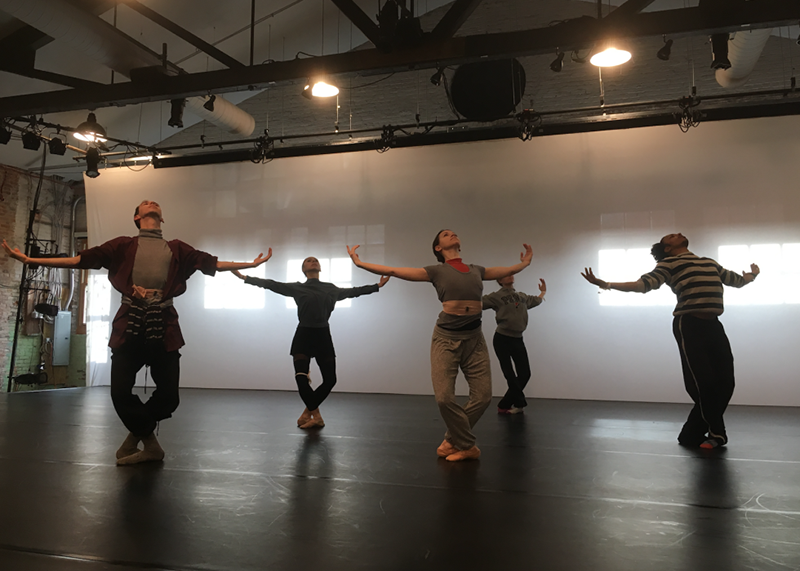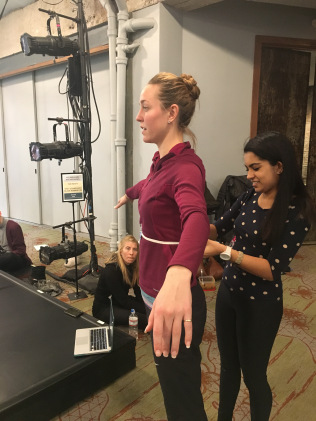 A spin, a lift, the tilt of a leg, the extension of an arm – dance can be broken down into its elemental form, but the ability to combine those elements to produce a beautiful piece of art is a rare talent. Even more difficult is attempting to reproduce that beauty in a uniform way. But a collaboration between Drexel University engineers and a professional dance company in Philadelphia is taking the first steps to develop an accessible method for formally measuring movement in dance. Their hope is the scientific data gleaned from it could one day support the teaching and appreciation of this form of artistic expression.
A spin, a lift, the tilt of a leg, the extension of an arm – dance can be broken down into its elemental form, but the ability to combine those elements to produce a beautiful piece of art is a rare talent. Even more difficult is attempting to reproduce that beauty in a uniform way. But a collaboration between Drexel University engineers and a professional dance company in Philadelphia is taking the first steps to develop an accessible method for formally measuring movement in dance. Their hope is the scientific data gleaned from it could one day support the teaching and appreciation of this form of artistic expression.
 As part of the upcoming Philadelphia Science Festival, engineers from Drexel are teaming up with Nora Gibson Contemporary Ballet to create performances that display both the beauty of the physical artistry of ballet and of the physical science it represents. The performance, entitled “Nothing That Is Not There,” is a 50-minute program in which “physics, object oriented ontology, beauty and essence crystalize in this ambient, full-evening work,” according to Gibson.
As part of the upcoming Philadelphia Science Festival, engineers from Drexel are teaming up with Nora Gibson Contemporary Ballet to create performances that display both the beauty of the physical artistry of ballet and of the physical science it represents. The performance, entitled “Nothing That Is Not There,” is a 50-minute program in which “physics, object oriented ontology, beauty and essence crystalize in this ambient, full-evening work,” according to Gibson.
Leslie Lamberson, PhD, an assistant professor in the Mechanical Engineering and Mechanics Department of the College of Engineering, and Rochitha Nathan, an undergraduate in the School of Biomedical Engineering, Science and Health Systems, are helping Gibson punch up the physics aspects of the performance by providing an animated visual backdrop that relates directly to the movement of the eight dancers onstage.
The pair of engineers both share a passion for dance. Nathan has studied classical Indian dance for a number years, and Lamberson, who holds a degree in dance performance, has trained and danced with professional ballet companies around the United States. They have found a way to apply their engineering expertise to the art by quantifying and deconstructing its movement. Using accelerometer sensors that wirelessly connect to a smart phone app, affixed to the torso, arms and legs of the dancers, Lamberson and Nathan are able to collect data about how they move throughout the course of a performance — recording the subtle starts and stops, the slows, shifts and settles.
 Measurements were taken during the rehearsals of the piece and were used as inspiration for the choreography, which Gibson specifically created for the 2017 Philadelphia Science Festival. Lamberson and Nathan then used the computer software program MATLAB to visually translate the data as a series of modulating lines and shifting shapes. Those shapes correspond to changes in the dancer’s movement in three dimensions. So as the audience sees the dancers spring to life or fall to rest, the abstract movie playing out behind them helps the audience understand the relative rate and direction of acceleration or deceleration the performers are generating with their movements.
Measurements were taken during the rehearsals of the piece and were used as inspiration for the choreography, which Gibson specifically created for the 2017 Philadelphia Science Festival. Lamberson and Nathan then used the computer software program MATLAB to visually translate the data as a series of modulating lines and shifting shapes. Those shapes correspond to changes in the dancer’s movement in three dimensions. So as the audience sees the dancers spring to life or fall to rest, the abstract movie playing out behind them helps the audience understand the relative rate and direction of acceleration or deceleration the performers are generating with their movements.
According to Gibson, “Nothing That Is Not There” is particularly well-suited for this type of scientific exploration because it is a minimalist examination of the natural patterns of movement.
“This piece is intended to be shared acknowledgement of what is beautiful in nature,” Gibson said. “That beauty has an innate structure that we are only beginning to understand thanks to scientific and mathematical analysis to tease out patterns like the prime number theory. Science can help us more fully understand, appreciate and share beauty with others, so I think it’s important to continually look at artistic expression through the lens of science — which is exactly what this collaboration is doing.”
The group also sees this as a small step toward providing a new way of interpreting and teaching dance — one that incorporates both training in movement, and also study of the physical principals that it comprises.
“I was always fascinated that the way dance is taught to students is pretty much void of any physics or mechanics,” Lamberson said. “It’s purely qualitative, you use the mirror in the studio to mimic the teacher and figure it out from there based on the set of rules that ballet applies which is almost 100 percent form — not motion — directed. Yet to be a good dancer, understanding physics will absolutely help — so why wouldn’t dance education curriculums require any physics education?”
When instructions are given to dancers, they use terms like “turn-out, on relevé, double-time, effacé,” which pertain to the body part, the direction of and dynamic quality of movement and its duration. They are explained in dance texts based on foundational principles of positioning and movement called “Labanotation.” These elements create the style of a dance and the signature of a choreographer. Their assessment, though qualitative, is the standard for maintaining a recognized level of professionalism in the performance of particularly prestigious pieces.
“Choreography composition for dancers is also taught purely in terms of aesthetics,” Lamberson said. “Is it that unfortunate stereotype that right brain people can’t be left, and vice versa, that keeps us from trying to add a different more scientific lens to it. I think that’s something we need to move beyond, if our goal is to make this art form accessible to a broader audience.”
The team suggests that even modest projects like this — using existing technology in new ways to add a level of quantitative analysis to dance could successfully advance teaching, assessment and understanding of choreographic style.
“Groups like the Balanchine Trust preserve and protect these creative works and pass them down from generation to generation—but it’s all quite subjective when you get right down to it,” Gibson said. “I see this as way to objectively measure aspects of dance, it could be used as a tool for advancing artistry.”
“Nothing That is Not There,” along with the Drexel visual accompaniment, was performed on April 21 and 22 at the Science Festival’s Performance Garage. The performances were presented by Drexel, The Franklin Institute and Nora Gibson Contemporary Ballet Company. The 8 p.m. performance was preceded by a presentation by Gibson about the performance at 7 p.m.
The performance is one of many Science Festival events that will feature the work of Drexel students and faculty. Get more information about the Festival.